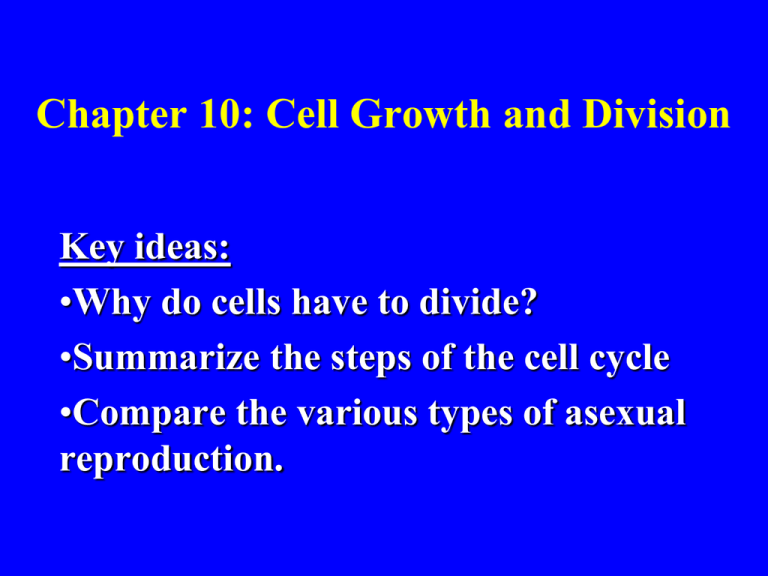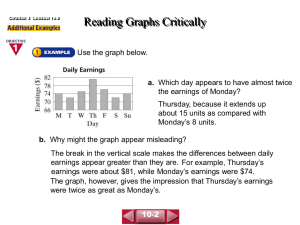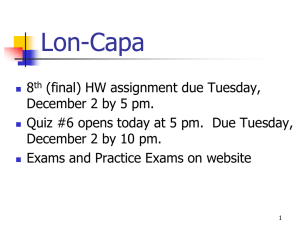Chapter 10 notes - Vista del Lago High School
advertisement

Chapter 10: Cell Growth and Division Key ideas: •Why do cells have to divide? •Summarize the steps of the cell cycle •Compare the various types of asexual reproduction. Cell Size • Cell size is not determined by the size of an organism. (Most cells of a mouse and giraffe are about the same size) Exception: nerve and muscle cells 10-1 Cell Size • In most cases, organisms get larger because they produce more cells, not because their cells become larger. • So why don’t cells just get larger? – There are 2 reasons . . . ? 10-1 Reason 1: DNA Overload • The nucleus can control only a limited amount of living, active cytoplasm. SO Cells have to remain small. 10-1 Reason 2: Exchanging materials As cells get bigger, the need for nutrients and waste production increase. Wastes have to get out, nutrients in. 10-1 Surface area-to-volume ratio As cell size increases, volume increases faster than surface area. If the cell is too big, it won’t be able to get nutrients to center of cell and eliminate waste fast enough. 10-1 10-2: Cell Division Std: 7 1e: Cells divide to increase their numbers through mitosis. This results in 2 identical cells. 10-2 10-2: Cell Division • When a cell reaches maximum size, nucleus initiates cell division. – splitting of 1 cell into 2 new daughter cells – 2 phases: • Mitosis (division of the nucleus) • Cytokinesis (division of the cytoplasm) 10-2 Cell division • The result of cell division is 2 identical daughter cells. • In plants and animals (humans) this begins right after fertilization. 10-2 10-2 Important information has to be passed from parent to daughter cells. • This information is carried in chromosomes. (chrom’s) • Every organism has a specific number of chrom’s 10-2 Humans have 46 chromosomes (23 pairs) in each body cell. A hamster has 44 chrom’s (22 pairs) in each body cell. An onion has 16 chrom’s (8 pairs) in each cell. 10-2 10-2 • Chromosomes only visible during cell division. • Before cell division begins, genetic material must be copied, or replicated. – Replication creates 2 identical chromatids. 10-2 Replicated chromosomes Centromere Chromatids **Chromosomes only look like this before cell division** 10-2 1 Homologous chromosome pair (1 from mom, 1 from dad) Sister chromatids Centromere Replication 10-2 Anatomy of a chromosome One from mom, one from dad (homologous pair) Gene for brown eyes } Exact copies (sister chromatids) } Gene for blue eyes 10-2 The Cell Cycle has 6 Stages (phases): • Interphase • Prophase • Metaphase • Anaphase • Telophase • Cytokinesis Mitosis is these 4 stages 10-2 10-2 Interphase • • • • 90% of cell cycle. Animal growth and development. genetic material makes copy of itself. organelles are made. “Interphase: In-between” Plant 10-2 10-2 Prophase • Chromosomes become visible. • Nuclear membrane disappears “prophase party” 10-2 Metaphase • Chromosomes align along middle of cell. “Metaphase:Middle” 10-2 Anaphase • Centromeres divide • sister chromatids pulled to opposite ends of cell. “Anaphase:Apart” 10-2 Telophase • Nuclear membrane forms. • Cytoplasm divides and 2 daughter cells are formed. New cells have same number of chromosomes as original cell. Cell plate “Telophase:Two” 10-2 Cytokinesis • Animal vs. plant cells • Animal: “pinching-in of cell membrane. • Plant: formation of cell plate. 10-2 Cytokinesis “pinching in” Cell plate The Cell Cycle • Interphase • “Prophase Party” • “Metaphase Middle” • “Anaphase apart” • “Telophase TWO” and Cytokinesis “That’s the cell cycle broken down into pieces.” If no final division, you get a multinucleated cell. Muscle cells fungi 20-1 Complete the following: • When a cell reaches a certain size, the nucleus initiates _________ ________. • The life of a cell is composed of 6 stages which are collectively called the ___ ___. • Chromosomes are copied by a process called: ______________. • Mitosis is composed of ______ stages. 20-1 Repair • Mending of damaged tissues (regeneration). 20-1 Repair 20-1 Reproduction • Asexual reproduction: reproduction resulting from simple cell division. Only 1 Parent Offspring are genetically identical to parents 20-1 Asexual reproduction in animals • • • • Sponges Sea stars Worms Stem cell research – Growing new organs from single cell? – Cloning • Sheep, cat, cattle, mule, deer 20-1 How does this process of cell division, which allows growth, repair, reproduction, occur? How does cell division happen? 20-1 20-2: Asexual Reproduction 20-2 Asexual reproduction • Product of mitotic cell division • Produces identical offspring • Examples: –Binary fission in bacteria –Budding in yeast –Regeneration –Vegetative reproduction 20-2 Binary fission (bacteria) 20-2 Budding (yeast) 20-2 Regeneration This is more characteristic of simple, rather than complex organisms. 20-2 Vegetative propagation (production of new plants) 20-2 Advantages of vegetative propagation: • Offspring exactly like parent (plants grown from seed don’t always show same traits as parents). • Faster than from seed. • Only way to propagate seedless fruit! 1 Homologous chromosome pair (1 from mom, 1 from dad) Sister chromatids Centromere Replication









